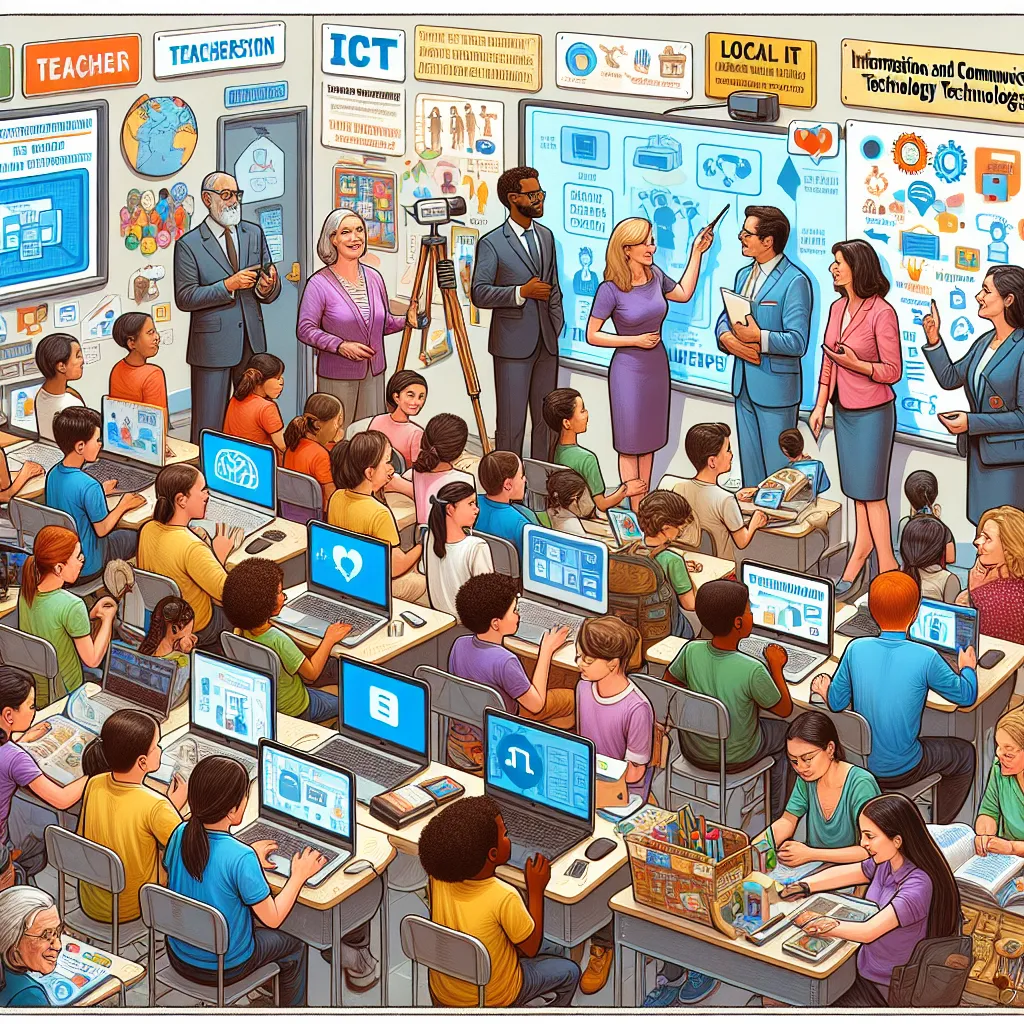Ask AI on The Internet
Question: Discuss the importance of continuous professional development for educators concerning ICT integration. Outline specific training and support mechanisms that can empower teachers to use ICTs effectively. [10] 7. Explore the role of partnerships with local businesses or organizations in aiding South African schools with ICT resources and support. Provide examples of successful collaborations. [10] Part 3: Reflection and Future Action (20 marks) 8. On your personal experiences or observations regarding ICT integration in education. Share one specific example of successful ICT use in a classroom or educational setting and analyse why it was successful. [10] 9. As a prospective educator or concerned individual, propose three actionable steps that you can take to contribute to the integration of ICTs in South African schools. Explain how these actions could positively impact the educational landscape. [10] the answers must be lengthy
**Part 1: Importance of Continuous Professional Development for Educators Concerning ICT Integration [10]** **1. Importance of Continuous Professional Development for Educators:** Continuous professional development (CPD) is crucial for educators to remain up-to-date with the latest advancements in technology and integrate ICT (Information and Communication Technology) into their teaching practices effectively. The rapid evolution of technology necessitates that educators continuously enhance their skills and knowledge to keep pace. Here are several reasons why CPD is essential in the context of ICT integration: * **Adaptation to Technological Changes:** Technology rapidly evolves, and staying current is vital. CPD ensures educators possess the latest knowledge and skills to utilize new tools and technologies effectively. * **Enhanced Teaching Effectiveness:** When educators are well-versed in ICT, they can design engaging, interactive, and meaningful lessons, which can lead to improved student outcomes. * **Student Engagement:** ICT integration can make learning more enjoyable and stimulating, thereby increasing student engagement. Educators need CPD to learn how to best harness these tools to capture students' interest. * **Digital Literacy:** Educators must not only teach but also model digital literacy for their students. CPD helps them become proficient in using digital resources responsibly and effectively. * **Meeting Curriculum Demands:** Modern curriculums increasingly incorporate ICT. Continuous training ensures educators can meet these demands and utilize ICT to enhance their lessons. * **Confidence Building:** Ongoing professional development builds educators' confidence in using ICT, making them more likely to implement these tools in their teaching. * **Collaboration and Innovation:** Training programs often provide platforms for educators to collaborate and share innovative teaching practices, thereby fostering a culture of continuous improvement and adaptation. **2. Specific Training and Support Mechanisms:** To empower educators to use ICTs effectively, several training and support mechanisms can be implemented: * **Workshops and Seminars:** Regular workshops and seminars focused on specific ICT tools and their classroom applications can provide hands-on experience and immediate feedback. * **Online Courses and Webinars:** Flexible, self-paced online courses and webinars can allow educators to learn new ICT skills at their convenience. * **Mentorship Programs:** Pairing less experienced teachers with tech-savvy mentors can provide personalized guidance and support. * **In-Service Training:** Periodic in-service training programs can keep educators updated with the latest ICT developments and teaching methodologies. * **Resource Centers:** Establishing ICT resource centers within schools or districts can provide educators with access to tools, software, and technical support. * **Collaborative Networks:** Encouraging the formation of professional learning communities where educators can share experiences and strategies for ICT integration. * **Technical Support:** Providing ongoing technical support to help educators troubleshoot and resolve issues promptly. * **Incentive Programs:** Offering incentives for educators who proactively seek out and participate in ICT-focused CPD can motivate more teachers to engage in these opportunities. * **Integration into Teacher Education Programs:** Embedding ICT training into teacher education programs ensures that new educators enter the profession with a foundational understanding of how to integrate technology effectively. **Part 2: Role of Partnerships with Local Businesses or Organizations in Aiding South African Schools with ICT Resources and Support [10]** **3. Role of Partnerships with Local Businesses or Organizations:** Partnerships with local businesses or organizations play a pivotal role in supporting South African schools with ICT resources and expertise. These collaborations can address resource shortages and enhance the educational experience. Here’s how such partnerships can be beneficial: * **Resource Provision:** Businesses can provide schools with the necessary hardware (computers, tablets) and software, enhancing access to technology. * **Financial Support:** Local businesses can offer financial sponsorships or grants to schools for purchasing ICT equipment or funding ICT-related projects. * **Technical Expertise:** Companies, especially those in the tech sector, can offer their expertise by providing technical support and maintenance services, ensuring the technology in schools remains functional and up-to-date. * **Professional Development:** Organizations can sponsor or conduct training sessions for teachers, ensuring they are well-equipped to use the latest ICT tools effectively. * **Real-World Learning Opportunities:** Businesses can offer students practical experiences such as internships or project collaborations involving ICT, enhancing their real-world skills and employability. * **Community Engagement:** Businesses engaged in CSR (Corporate Social Responsibility) initiatives can foster stronger community ties by supporting local education and thereby investing in the future workforce. **4. Examples of Successful Collaborations:** * **Vodacom Foundation:** Vodacom’s e-School programme offers free access to quality educational content via mobile devices, reaching hundreds of thousands of students across South Africa. * **Mhlobo Wenene FM’s HCI Foundation:** This initiative has donated computers and set up computer labs in several under-resourced schools, providing both the hardware and the necessary training for teachers. * **Dell’s Youth Learning Program:** Dell has partnered with several NGOs to equip schools with ICT resources and provide training programs designed to enhance digital literacy skills among students and educators. **Part 3: Reflection and Future Action [20]** **5. Personal Experiences or Observations Regarding ICT Integration in Education:** During a volunteering stint at a local high school, I observed a teacher effectively using interactive whiteboards and educational software in her mathematics class. The teacher utilized a combination of visual aids, interactive simulations, and real-time problem-solving exercises. This approach allowed students to visualize complex mathematical concepts and engage with the material dynamically. The key reasons for its success included: * **Engagement:** The interactive nature of the technology captured the students' attention and made the learning experience more enjoyable. * **Immediate Feedback:** The software provided instant feedback on students’ answers, enabling them to understand and correct mistakes in real-time. * **Differentiation:** The technology allowed for differentiated instruction, catering to students with varying levels of understanding by providing additional support or advanced challenges as needed. * **Accessibility:** Visual and interactive components made learning more accessible for students with different learning styles, particularly visual learners. **6. Three Actionable Steps to Contribute to the Integration of ICTs in South African Schools:** * **Step 1: Establish Partnerships:** Actively seek out and cultivate partnerships with local businesses, tech companies, and NGOs to provide resources, funding, and expertise to schools. This could involve organizing fundraising events, proposing CSR initiatives to companies, or applying for grants. * **Impact:** These partnerships can provide schools with the much-needed resources and support to fully leverage ICT in education, subsequently leading to enhanced learning experiences and better educational outcomes. * **Step 2: Conduct Teacher Training Workshops:** Organize and facilitate CPD workshops focused on ICT integration. These workshops can be conducted by partnering with universities, tech companies, or online education platforms. * **Impact:** Empowering teachers with the necessary skills and confidence to use ICT effectively can transform the classroom environment, making learning more interactive and engaging. * **Step 3: Promote Digital Literacy Programs for Students:** Launch initiatives such as after-school ICT clubs or coding workshops where students can learn essential digital skills. Collaborate with local universities or tech organizations to provide regular sessions. * **Impact:** By enhancing students’ digital literacy, we prepare them for the future job market, ensuring they possess the skills needed in a digital world and an increasingly tech-dependent economy. In summary, continuous professional development and strategic partnerships play a critical role in integrating ICT in education. Personal experiences highlight the tangible benefits technology can bring to the classroom, and targeted actions can further this integration, ultimately benefiting the entire educational landscape of South Africa.
Think your answer is better than the AI's? Post it below.
Other Most Relevant Posts:
 1. **ICT in South African Education**
2. **Challenges to ICT Integration**
3. **Digital Divide in Schools**
4. **SAMR Model for Educators**
5. **Innovative ICT in Classrooms**
6. **Professional D
1. **ICT in South African Education**
2. **Challenges to ICT Integration**
3. **Digital Divide in Schools**
4. **SAMR Model for Educators**
5. **Innovative ICT in Classrooms**
6. **Professional D
Question Tags
If you want your question answered by an AI, click here.






Post your own comment: